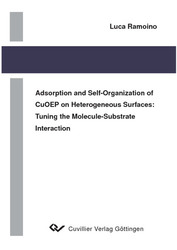| Areas | |
|---|---|
| Serie de libros (96) |
1378
|
| Nachhaltigkeit |
3
|
| Gesundheitswesen |
1
|
| Letra |
2363
|
| Ciencias Naturales |
5406
|
| Matemática | 229 |
| Informática | 319 |
| Física | 980 |
| Química | 1363 |
| Geociencias | 131 |
| Medicina humana | 243 |
| Estomatología | 10 |
| Veterinaria | 108 |
| Farmacia | 147 |
| Biología | 835 |
| Bioquímica, biología molecular, tecnología genética | 121 |
| Biofísica | 25 |
| Nutrición | 45 |
| Agricultura | 1004 |
| Silvicultura | 201 |
| Horticultura | 20 |
| Ecología y conservación de la tierra | 148 |
| Ciencias Ingeniería |
1791
|
| General |
98
|
|
Leitlinien Unfallchirurgie
5. Auflage bestellen |
|
Erweiterte Suche
Adsorption and Self-Organization of CuOEP on Heterogeneous Surfaces (Tienda española)
Tuning the Molecule-Substrate Interaction
Luca Ramoino (Autor)Previo
Indice, Datei (33 KB)
Lectura de prueba, Datei (270 KB)
The adsorption and self-organization of copper(II) octaethyl porphyrin (CuOEP) have been studied in detail on heterogeneous surfaces by Scanning Tunnelling Microscopy (STM), Low Energy Electron Diffraction (LEED) and Ultraviolet Photoelectron Spectroscopy (UPS). The research has been focussed both on the adsorption of CuOEP on clean metals as well as on ultrathin sodium chloride films grown on metals. For this reason, in a first stage, the growth of NaCl films on Cu(111), Ag(111) and Ag(001) has been carefully investigated. For submonolayer coverages the samples show the formation of NaCl islands with a characteristic rectangular shape, which coexist with clean metal regions. Salt structures 1 to 3 ML thick can be identified. CuOEP molecules have been deposited on the so prepared heterogeneous salt-metal surfaces. STM reveals that the molecules self organize in ordered monolayers on the bare metal areas as well as on the NaCl islands. Series of observations performed by increasing the CuOEP coverage in steps from 0 to 1 ML revealed that the assembly develops in a hierarchical fashion. Molecules sequentially adsorb and assemble first on the bare metal, then on the 1-layer and 2-layer thick NaCl areas. From these observations it can be inferred that the adsorption energy of CuOEP decreases by introducing an insulator layer and by increasing its thickness. Moreover, the investigation of the STM appearance of CuOEP as a function of the bias voltage, indicates a weaker adsorbate-substrate interaction on the NaCl/metal system than on the bare metal. The adsorption of CuOEP on the clean metal has been further investigated by LEED and UPS. Combining LEED and STM, the structure of the molecular layer formed on Cu(111), Ag(111) and Ag(001) is determined. Information on the adsorption conformation of CuOEP has also been gained by high resolution STM. In these measurements several intramolecular features can be recognized and they fit very well with simulated STM images based on DFT calculations. The theoretical predictions of the molecular orbital energies fit also very well with the UPS measurements. In particular the position and the relative intensity of HOMO and HOMO-1 levels show a very good agreement between experiment and calculation. UPS has also been used to measure the work function change of the various metal substrates upon CuOEP adsorption. These experiments prove that, for all metal investigated, a charge transfer from the molecule to the substrate takes place. This charge transfer is found to depend on the work function of the substrate. In particular the comparison between the Ag(111) and Ag(001) cases demonstrates that the observed work function change does not depend only on the chemistry of the substrate but also on the details of the surface electronic structure.
| ISBN-10 (Impresion) | 3865376401 |
| ISBN-13 (Impresion) | 9783865376404 |
| ISBN-13 (E-Book) | 9783736916401 |
| Idioma | Alemán |
| Numero de paginas | 110 |
| Edicion | 1 Aufl. |
| Volumen | 0 |
| Lugar de publicacion | Göttingen |
| Lugar de la disertacion | Basel |
| Fecha de publicacion | 17.10.2005 |
| Clasificacion simple | Tesis doctoral |
| Area |
Física
|








